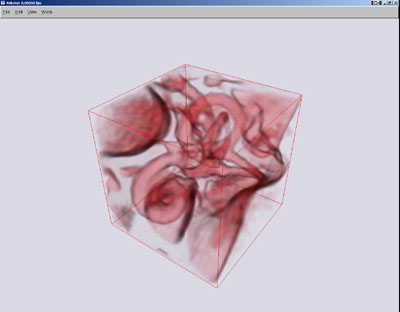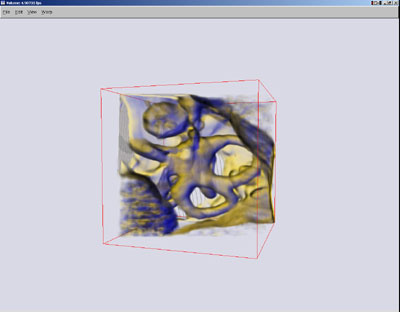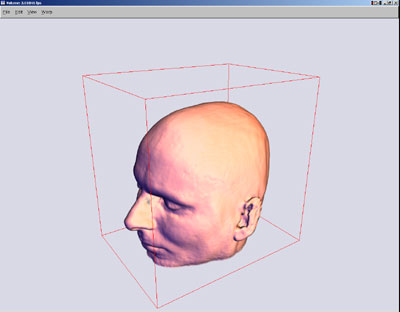Non-Photorealistic Real-time Volume Rendering
Brandon Ellenberger and K. Evan Nowak
Project Description
Our goal was to alter previously implemented real-time volume
rendering methods to
generate non-photorealistic styled output. Real-time volume
methods generate representations of volumes by storing pre-computed
volume data in 3D textures in hardware. These 3D texture are
then
accessed and blended using a series of view-facing polygons that slice
into the textures. One can achieve different effects by
changing how the polygons are rendered and blended. Modern
hardware shading languages provides a large degree of flexibility in
how texture data can be altered and represented.
We used the OpenGL Shading Language (GLSL) in order to implement a
number of NPR methods that are described in a paper by David Ebert and
Penny Rhenigans, Volume illustration: non-photorealistic
rendering of volume models (IEEE Visualization 00). The NPR
methods we have implemented are: boundary
enhancement,
silhouette enhancement, edge
coloring, distance coloring, tone
shading and
toon shading. We also experimented with
second order derivative filters, specifically the Laplacian
filter, for finding significant volume features. Following is
a short description of each method and
results:
Boundary Enhancement
For this method the opacity of each voxel-sample is enhanced based on
the gradient magnitude of that voxel. The gradient magnitude is
precomputed and stored as a float texture in hardware. This
effect can serve to emphasize regions of contrast in a volume.
Below is the equation we use to determine the opacity
contribution based on the gradient magnitude.
Here the gradient magnitude is normalized across the volume so that the
values range from 0 to 1. The boundary exponent serves to change
the sensitivity of the magnitude.
The only opacity contribution in this image is that of the boundary
enhancement equation. Notice that certain features in the volume
are more opaque than others, particularly the boundary between the air
and skull and skin, and between the skull and the brain tissue.
The darkness in the image is the
result of diffuse shading.
Silhouette Enhancement
To enhance the volumes silhouettes the opacity of each volume sample is
enhance based on that voxel's gradient direction relative to the
viewer.
The gradient is also stored in a 3D texture. The amount of
enhancement is proportional to the perpendicularity of the voxel, as
demonstrated by this equation:
In this image only the features that are perpendicular to the viewer
are opaque, for example the outline of the skull and the creases in the
brain.
Edge Coloring
In order to further enhance the edges of the volume, voxels are
darkened based on their orientation relative to the view
direction.
Perpendicular voxels are colored black, whereas voxels more
parallel to the viewing direction are not changed. This achieves
the effect of outlining the perpendicular edges of the volume.
Rather than simply color a voxel-fragment black, we
mix between the diffuse color and black based on the perpendicularity
of the gradient. Certain voxels are not darkened at all according
to a threshold
parameter.
Here diffuse lighting is turned off and the only voxel-samples that are
darkened are those that are more perpendicular to the viewer.
Notice the dark edges around the nose, ear, brow and eyelids.
The volume with no shading is presented for comparison.
With no edge coloring, all the features except the outline of the
volume are lost.
Tone
Shading
We implemented the Gooch shading model in order to better accentuate
dim features. According to the Gooch model, colors range from
cool tones to warm tones rather than dark to light. The user can
specify the cool and warm colors and their contribution to the final
color:
Here we have the volume tone shaded compared to the simple diffuse
shaded volume. In the tone shaded volume the cool color is pure
blue and the warm color is pure yellow. Upon close inspection one
notices that the definition around the center curve of the brow is more
defined in the tone volume. (The volumes are being viewed from
slightly different view-points.)
Toon Shading
With toon shading the volume is rendered with 4 colors ranging in tones
based on the light's intensity at that point, giving a toon-like
effect. The user supplies a color which serves as the darkest of
the four and the three other colors are interpolated between the
supplied color and pure white.
Here the chosen color was pure red. The varying levels of
contrast provide an interesting, more artistic effect.
Distance Coloring
For this method the color of each voxel-sample in the volume is
augmented based on its depth into the volume relative to the viewer.
The depth value ranges between 0 and 1 where a depth of 1
corresponds to a voxel that is one diagonal's length into the volume:
In this equation, "dc" corresponds to the modulated contribution of the
distance color (distCol) and "color" corresponds to the color
accumulated so far by other methods.
In this image the rectangular volume is set to be colored pure red and
the distance color is pure green. As one might expect, the volume
becomes more green in the further parts of the volume.
Laplacian Filter
The laplacian filter is a second order spatial derivative filter that
highlights regions of rapid intensity change. We stored these
values in a volume texture in order to enhance significant features,
such as creases. Our trials were met with limited success as they
only worked on contrived geometric examples.
In this image we have used values of the laplacian texture to determine
whether or not a fragments should be colored black. If a
voxel-sample's laplacian value was relatively high or relatively low,
it was colored black. Notice on some of the outside creases
certain pixels are green. This occurs because the laplacian
values for the given voxel-sample were just outside of the range.
However, inclusion of these sample would require the coloring of
other pixels as well, such as the sides of the volume. A more
useful method would require further research into second order
derivatives.
More Results

This is a volume of a inner ear with only edge coloring turned on.
The edge color helps one distinguish between structures, however
it fails to provide depth cues.

Here is the same volume with boundary opacity enhancement, edge
coloring and distance coloring. This achieves a similar effect to
that of the last rendering, but with the distance coloring, the user to
better sense which structures are in front. The boundary
enhancement serves to make important structures more opaque.

Here we have the ear again with tone coloring and edge coloring turned
on, with the a clipping plane removing the front of the volume.
The tone shading does a good job of accentuating curvature.

Here is the MRI head with tone shading, edge coloring and a bit of the
normal color added in. This rendering illustrates the ability to
composite different effects.
Source Code
For those interested, here is the source to our GLSL fragment and
vertex shader:
NPR.frag
NPR.vert








